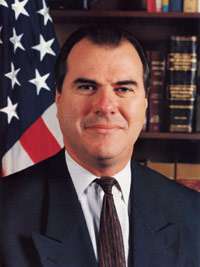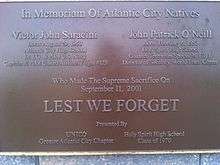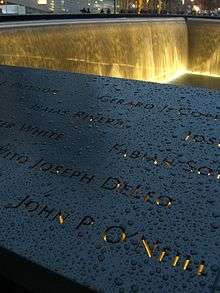John P. O'Neill
| John P. O'Neill | |
|---|---|
 | |
| Born |
John Patrick O'Neill February 6, 1952 Atlantic City, New Jersey, U.S. |
| Died |
September 11, 2001 (aged 49) New York, New York, U.S. |
| Nationality | American |
| Occupation | FBI special agent, World Trade Center security head |
John Patrick O'Neill (February 6, 1952 – September 11, 2001) was an American counter-terrorism expert, who worked as a special agent and eventually a Special Agent in Charge in the Federal Bureau of Investigation until late 2001. In 1995, O'Neill began to intensely study the roots of the 1993 World Trade Center bombing after he assisted in the capture of Ramzi Yousef, who was the leader of that plot.
He subsequently learned of al-Qaeda and Osama bin Laden, and investigated the 1996 Khobar Towers bombing in Saudi Arabia and the 2000 USS Cole bombing in Yemen. Partly due to personal friction he had within the FBI and federal government, O'Neill was pushed out of the Bureau in 2001. He became the head of security at the World Trade Center, where he died at age 49 in the September 11, 2001 attacks. In 2002, O'Neill was the subject of a Frontline documentary The Man Who Knew, and cast as the protagonist in the television miniseries The Path to 9/11 and the 2003 book, "The Man Who Warned America by Murray Weiss."

Early life and education
O'Neill was born in Atlantic City, New Jersey on February 6, 1952 and had a desire to become an FBI special agent from an early age. As a child, his favorite television show was The F.B.I.,[1] a crime drama based around true cases that the bureau had handled. After graduating from Holy Spirit High School, he went on to college, first attending American University in Washington, D.C. in 1971. While there, O'Neill also started working at the FBI's Washington headquarters, first as a fingerprint clerk and later as a tour guide.[2](p198) He gained a degree in administration of justice from American University in 1974 and later obtained a master's degree in forensics from George Washington University.
Career
1976–95
O'Neill was hired on as an agent at the FBI in 1976. Over the next 15 years, O'Neill worked on issues such as white-collar crime, organized crime, and foreign counterintelligence[1] while based at the Washington bureau. In 1991, O'Neill received an important promotion and was moved to the FBI's Chicago field office where he was assistant special agent in charge.[2](p199) While there, he established the Fugitive Task Force in an effort to promote inter-agency cooperation and enhance ties between the FBI and local law enforcement.[1] In 1994 O'Neill also became supervisor of VAPCON, a task force investigating abortion clinic bombings.[3][4]
1995–99
Returning to the Washington headquarters in 1995, he became chief of the counterterrorism section.[5] On his first day, he received a call from his friend Richard Clarke, who had just learned that Ramzi Yousef had been located in Pakistan. O'Neill worked continuously over the next few days to gather information and coordinate the successful capture and extradition of Yousef.[1] Intrigued by the case, O'Neill continued to study the 1993 bombing Yousef had masterminded and other information about Islamic militants. He was directly involved in the investigation into the June 1996 bombing of the Khobar Towers in Saudi Arabia, which took place during a retreat O'Neill had organized in Quantico for FBI and CIA counter-terrorism agents.[3] Frustrated by the level of cooperation from the Saudis, O'Neill purportedly vented to FBI Director Louis Freeh, saying that they were "blowing smoke up your ass,"[1] though Freeh later denied this, saying that they had an excellent relationship.[3]
In 1996 and 1997, O'Neill continued to warn of growing threats of terrorism, saying that modern groups are not supported by governments and that there are terrorist cells operating within the United States. He stated that veterans of the insurgency by Afghan rebels against the Soviet Union's invasion had become a major threat.[5] In January 1997 he moved to New York to be Special Agent in Charge of the FBI's National Security Division, the FBI's "largest and most prestigious field office".[3]
By 1998, O'Neill had become focused on Osama bin Laden, and created an Al Qaeda desk in his division.[3] In August 1998 two United States embassies were bombed in quick succession in simultaneous attacks in Nairobi, Kenya, and Dar es Salaam, Tanzania. O'Neill hoped to be involved in the investigation because he had gained a tremendous knowledge of Osama bin Laden's al-Qaeda terrorist network. O'Neill persuaded FBI Director Freeh to let his office handle the case, and prosecutor Mary Jo White later said that "John O’Neill, in the investigation of the bombings of our embassies in East Africa, created the template for successful investigations of international terrorism around the world."[3]
When his friend Chris Isham, a producer for ABC News, arranged for an interview between bin Laden and correspondent John Miller, Isham and Miller used information put together by O'Neill to formulate the questions. After the interview aired, O'Neill pushed Isham hard to release an unedited version so he could carefully dissect it.
O'Neill's rise through the ranks at the bureau began to slow as his personal style chafed others and he made a few slip-ups by losing a bureau cell phone and Palm Pilot, improperly borrowing a car from a safe house, and losing track of a briefcase with sensitive documents for a short period.[3] He was a Catholic, married with two children, but separated from his wife: she continued to live in Atlantic City and he supported them financially, paying the mortgage on their house. According to Lawrence Wright (in The Looming Tower) during the 1990s he was involved simultaneously in relationships with three other (named) women, and had told each of them either that he was not married or that he was divorced, and that he planned to marry them. He was officially reprimanded and docked fifteen days pay in summer 1999 over the incident involving the safe house, because he had allowed his girlfriend to enter it. His lifestyle, which involved frequent gifts to his girlfriends and lavish expenditure with his colleagues, resulted in substantial credit-card debts which he found difficult to manage on his salary, with the result that he also borrowed substantial sums from wealthy friends.[6]
In 1999, O'Neill sent a close associate named Mark Rossini to work in CIA's Bin Laden Issue Station in Virginia. He had a conflict with station chief Richard Blee; O'Neill wanted Rossini to stay at station and feed him information about what the CIA was doing, while Blee wanted him out working in the field. Later on, the CIA Bin Laden station learned that Bin-Laden associates Nawaf al-Hazmi and Khalid al-Mihdhar were headed to the US with Visas. Rossini and his associate Doug Miller attempted to alert O'Neill but the message was blocked by Blee. Mihdhar and Hazmi became two of the hijackers of American Airlines Flight 77 on 9/11.[7]
Following the December 1999 arrest of Ahmed Ressam, O'Neill co-ordinated the investigation into the 2000 millennium attack plots, described by Richard Clarke as "the most comprehensive investigation ever conducted before September 11th."[3]
2000
After being passed over for multiple promotions (assistant director in charge of national security in 1999, and head of the FBI's New York office in early 2000[3]), O'Neill was pleased to be assigned as commander of the FBI's investigation into the USS Cole bombing in October 2000. However, upon arriving in Yemen, he complained about inadequate security. As his team investigated, O'Neill came into conflict with Barbara Bodine, the U.S. ambassador to Yemen. The two had widely divergent views on how to handle searches of Yemeni property and interviews with citizens and government officials, and they only grew further apart as time progressed.[5]
After two months in Yemen, O'Neill returned to New York. He hoped to return to Yemen to continue the investigation, but was blocked by Bodine and others; the dispute made the US press.[5] Following threats against the remaining FBI investigators, FBI Director Freeh withdrew the team, on O'Neill's recommendation, in June 2001.[3]
Retirement
In early 2001 Richard A. Clarke, the National Coordinator for Security, Infrastructure Protection, and Counter-terrorism, wanted to move to another position; he insisted O'Neill was the best person to replace him. O'Neill proved reluctant not least because of the relatively low salary.[3] When O'Neill heard of upcoming leaks to the New York Times about the May 2000 incident in which his briefcase had been stolen, he decided to retire in favor of a higher-paying job in the private sector, as chief of security at the World Trade Center.[3]
An August 19, 2001 New York Times report[8] by James Risen and D.Johnston suggested that O'Neill had been the subject of an "internal investigation" at the FBI. The report suggested that O'Neill was responsible for losing a briefcase with "highly classified information" in it, containing among other things "a description of every counterespionage and counterterrorism program in New York." The briefcase was recovered shortly after its disappearance. The FBI investigation was reported to have concluded that the suitcase had been snatched by local thieves involved in a series of hotel burglaries, and that none of the documents had been removed or even touched.[8]
Several people came to O'Neill's defense, suggesting that he was the subject of a "smear campaign".[8] One of O'Neill's associates claimed later that O'Neill believed the source for the Times story was FBI official Thomas J. Pickard.[9] The Times reported that O'Neill was expected to retire in late August.
O'Neill has been described as having a close working relationship with Ali Soufan.[10]
O'Neill started his new job at the World Trade Center on August 23, 2001.[3] In late August, he talked to his friend Chris Isham about the job. Jokingly, Isham said, "At least they're not going to bomb it again," a reference to the 1993 World Trade Center bombing. O'Neill replied, "They'll probably try to finish the job."[3]
Death

O'Neill was killed on the day of the attacks, and his remains were recovered from the World Trade Center site on Friday September 21, 2001.[11] According to eyewitnesses, O'Neill was coordinating the evacuation efforts on one of the top floors with disregard to the threat for his own life—he was last seen at the 49th floor shortly before the tower collapsed.
Legacy
There is extensive coverage of O'Neill's anti-terrorist work at the FBI and insights into his character and his private life in the books The Man Who Warned America (2003) by Murray Weiss, The Looming Tower (2006) by Lawrence Wright and The Black Banners (2011) by Ali Soufan.
At the National 9/11 Memorial, O'Neill is memorialized at the North Pool, on Panel N-63.[12]
Michael Scheuer, described in 2006 by the Washington Times as "a 22-year veteran with the CIA, [who] created and served as the chief of the agency's Osama bin Laden unit at the Counterterrorist Center" called O'Neill and Richard Clarke "two principal authors of September 11".[13] He bases this statement on the refusal of Clarke and O'Neill to agree to his offers to have bin Laden assassinated. Scheuer said of O'Neill, "little needs to be said. In my own experience, [he] was interested only in furthering his career and disguising the rank incompetence of senior FBI leaders. He once told me that he and the FBI would oppose an operation to capture bin Laden and take him to a third country for incarceration. When I asked why, he replied, 'Why should the FBI help to capture bin Laden if the bureau won't get credit among Americans for his arrest and conviction'?"[13]

He is buried in Holy Cross Cemetery in Mays Landing, New Jersey.[14]
See also
- Rick Rescorla, Vietnam War veteran and Morgan Stanley's WTC head of security who died in the attacks on 9/11
References
- 1 2 3 4 5 "A Chronology of John O'Neill's Life and FBI Career". Frontline. Retrieved May 12, 2015.
- 1 2 Graff, Garrett M. (2011). The Threat Matrix: The FBI at War in the Age of Global Terror. Little, Brown & Company. ISBN 9780316068604.
- 1 2 3 4 5 6 7 8 9 10 11 12 13 14 Wright, Lawrence (January 14, 2002). "The Counter-Terrorist". New Yorker. Retrieved May 12, 2015.
- ↑ Pogrebin, Robin (September 23, 2001). "John O'Neill Is Dead at 49; Trade Center Security Chief". New York Times.
- 1 2 3 4 Kolker, Robert (December 17, 2001). "O'Neill Versus Osama". New York. Retrieved May 12, 2015.
- ↑ Wright, Lawrence (2006). The Looming Tower: Al-Qaeda and the Road to 9/11. New York: Vintage. ISBN 978-0141029351.
- ↑ Nowosielski, Ray, and John Duffy secrecykills.com website Audio documentary transcript entitled Who is Rich Blee? (September 20, 2011)
- 1 2 3 Johnston, David; Risen, James (August 19, 2001). "F.B.I. Is Investigating a Senior Counterterrorism Agent". The New York Times.
- ↑ The Man Who Knew. Frontline PBS
- ↑ Edmonds, Sibel "Podcast Show #55: The Boiling Frogs Presents Ray Nowosielski & John Duffy ". Sibel Edmonds' Boiling Frogs. 51:55 mark. September 10, 2011.
- ↑ "FBI terrorist fighter's body found at WTC". CNN. September 22, 2001. Retrieved April 16, 2015.
- ↑ "North Pool: Panel N-63 - John P. O'Neill". National September 11 Memorial & Museum. Retrieved October 29, 2011.
- 1 2 Michael Scheuer (July 5, 2006). "Bill and Dick, Osama and Sandy; Will ABC remake the whitewashing of pre-September 11 intelligence?" Washington Times A17.
- ↑ "John P. O'Neill (1952 - 2001) - Find A Grave Memorial". findagrave.com. Retrieved 2015-09-12.
- Weiss, Murray, "The Man Who Warned America: The Life and Death of John O'Neill, the FBI's Embattled Counterterror Warrior'", ISBN 0-06-050822-1
External links
| Wikimedia Commons has media related to John P. O'Neill. |
- "FBI terrorist fighter's body found at WTC". CNN. New York City. September 22, 2001. Retrieved September 7, 2016.
- Frontline: The Man Who Knew | PBS Frontline published October 3, 2002
- Frontline: The Man Who Knew transcript | PBS Frontline (c) 2002
- Frontline: Bush's War: video timeline | PBS Frontline 1980s–2007 posted March 24, 2008
- Probe of USS Cole Bombing Unravels Washington Post May 4, 2008
- Junod, Tom (1 March 2002), "The Man Who Was Supposed To Save Us", Esquire, archived from the original on June 29, 2009, retrieved 11 September 2012
- John P. O'Neill at Find a Grave